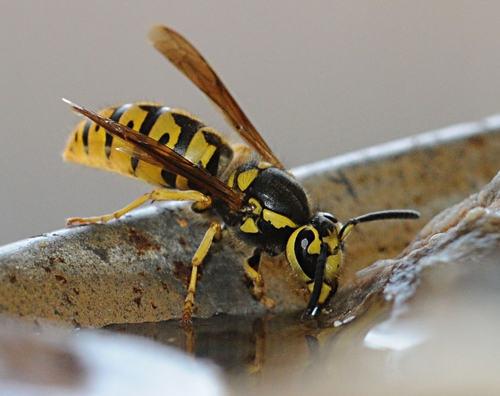
You want to make sure that Mr. and Mrs. Yellowjacket and all their offspring--plus nephews, nieces, uncles, aunts, cousins and assorted other relatives--aren't on the invite list.
And if you're a beekeeper, you don't want them killing your honey bees. "They pull the bees off at the entrance, dismember them and fly away with the parts--generally the head--to feed to their larvae," said Extension apiculturist Eric Mussen (right) of the UC Davis Department of Entomology.
Indeed, these predatory insects can be a major problem this time of the year.
When Mussen addressed the Santa Clara County Beekeeping Guild on Monday, Oct. 4, he asked the 60 attendees: "How many of you have had significant problems with yellowjackets?"
About eight hands shot up.
What to do?
"It was around a decade ago that we lost the use of flowable microencapsulated diazinon (Knox Out 2FM^® ) as a yellowjacket bait poison," Mussen said in a message he also shared today with the UC Davis Department of Entomology. "As long as the wasps did not taste it, they would take the contaminated bait back to the nests and share it with their brood and other adults. It was amazing! Often in 48 hours the colonies were out of business and the area was clear of yellowjackets."
Recently, a new microencapsulated product, Onslaught^® , containing esfenvalerate, has come on the market to be mixed into yellowjacket baits, Mussen said. Formulating the bait is the same as it was with diazinon--about 1/4 teaspoonful of the insecticide in about 12 ounces of the bait.
Yellowjackets are attracted to many odorous potential foods when their prey runs out and they turn to scavenging, said Mussen, adding that the chemical seems quite a draw when it's mixed with canned, fish-based cat food.
"Try a couple samples of cat food without insecticide to see which product is most attractive to your local yellowjacket population. Then place about three ounces of formulated bait in each trap and things should get better fast."
"You can find this product on the web as Alpine Yellowjacket Bait Station Kit. A multi-year supply (one pint) of microencapsulated esfenvalerate and four bait stations--they look like over-sized, plastic prescription bottles with a hole in the side and a string for hanging--will cost about $85 before shipping. Sounds like a lot of money for a small amount of product, but if you need to clear out the yellowjackets in a hurry--wedding reception, fair, outdoor barbecue, your own peace of mind-- this is a good investment."
And don't even think about inserting insecticidal wasp baits in that empty soda bottle lying on the ground near your picnic table. It's illegal to put pesticides, including insecticidal wasp baits, into used food and drink containers.
"The last thing you would want is for someone to accidentally eat or drink your poisoned bait," he said.
Attached Images:

Western yellowjacket